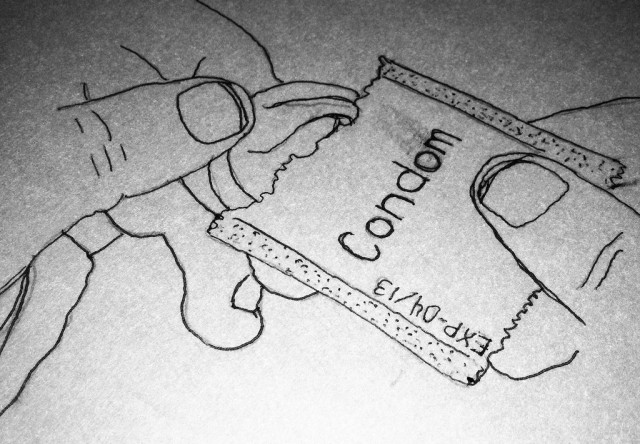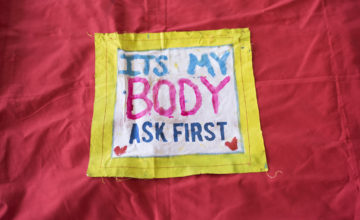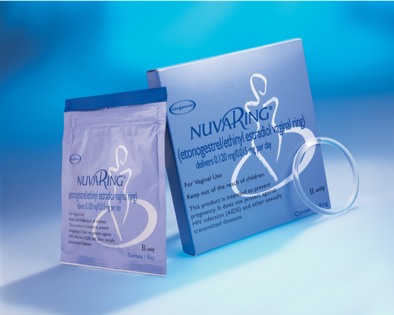
April is STD Awareness Month!
Consistent and correct condom use reduces the risk of HIV transmission by as much as 10,000 times (the studies that reported the HIV virus leaking through latex were done using particles 100 million times smaller than the HIV found in semen). And while condoms admittedly do not cover all the genital skin through which some infections can be passed (such as herpes and HPV), they do cover the areas of the penis where the majority of sexually transmitted diseases and infections hang out. In fact, failure to use condoms has been shown to be one of the highest risk factors for contracting the HPV infections that can cause cervical cancer.
By reducing the exchange of the bodily fluids most likely to carry sexually transmitted infections (ejaculate, vaginal secretions, saliva, sore discharges), condoms are pretty much the only form of birth control that can help protect against said STDs. (Diaphragms and spermicides might help with some infections, but they don’t hold a candle to condoms.)
When your worries about STDs and pregnancy are reduced, you can better focus on the matter at hand: You and your partner’s pleasure. Condoms are readily available, inexpensive, disposable, and cause few side effects, if any. Goooooooo condoms!
1. Invest in quality.
If you’re one of those annoying people who whine about condoms, could it be you’ve been using non-lubricated, inch-thick, five-cent prophylactics from a vending machine all your life? Today there’s a whole slew of available materials (e.g. polyurethane), sizes and shapes (balloons and and studs and ribs that actually work) designed not only to protect, but to provide pleasure. Seek out thinner varieties for a warmer, more natural feel — as long as they’re FDA approved, they’ve passed the same safety requirements the thicker brands have. And if your budget allows for it, pay a little extra. These are your family jewels, after all. Don’t they deserve the very best?
2. Get the size right.
Studies suggest that the better the fit, the safer and more comfortable the condom will be for both partners. Resist the temptation to get the “extra large” condoms just to feed your ego. If it’s too loose, it will slip off more easily. If a condom is too tight, not only will it break more easily, it’ll choke the nerve endings in the penis, reducing sensitivity. And if it’s too short, it’ll leave more skin exposed to possible infection and slip off more easily (though this is usually only a problem for men of the most porno proportions). Learn your size, then experiment with different lengths, widths, and shapes to get the right fit — a millimeter or two could make all the difference.
3. Don’t carry them around jammed in a pocket or wallet.
They get worn down that way. Get yourself a carrying case to keep them in good, working condition.
4. No genital-to-genital foreplay.
You must introduce condoms into the love scenario before any genital contact is made — bareback poking around increases your chances of STD transmission (whether through skin-to-skin contact or bodily secretions) and getting pregnant (yes, there can be traces of semen in pre-ejaculate from a previous ejaculation, for instance, if he hasn’t urinated since said ejaculation).
5. Make it part of the act.
If you make putting on a condom an integral part of sex, it’s inherently sexy. What could be hotter than kneeling above your partner, staring them straight in the eye, tearing the wrapper off a condom like a mini striptease, and oh so slowly unraveling it over the throbbing specimen in play? As Yogi Berra once said, “Half this game is ninety percent mental.” If you think it’s hot, then it will be.
6. Open the package carefully.
Once you’ve got the right condom in hand, open its wrapper along one side of the foil with relish. You might be tempted to use your teeth, but you’ll have better control with your hands (which means fewer chances of accidental damage to the condom). Remove the condom gingerly from the package, taking care not to poke the material with fingernails or jewelry.
7. Make sure you’ve got it right-side-round.
To quickly determine which side of the rolled up condom should be placed against the erect penis, you can blow gently into the reservoir tip — this will help you determine if the roll is on the outside (it should be).
8. Add lube.
Add two or three drops of water-based or silicone lubricant (never use oils, which degrade latex!) into the reservoir tip. This will make it easier to roll down, and increase sensation for him. Do not skip this step! (We’d avoid condoms with Nonoxynol-9 and desensitizing creams.) Once the condom is on, lovingly add more lubricant to the outside for the receiver’s pleasure.
9. Leave some room at the top, none at the bottom.
Pinch out the air from the receptacle end or top half-inch of the condom with your thumb and forefinger. Hold it against the head of the penis, leaving some space for any future fluids to collect, and roll the condom all the way down the shaft to the very base — as far as it will go — smoothing out any air bubbles along the way. Remember to make sure this feels good.
10. Deal with the foreskin.
If there’s foreskin involved, pull it back first, then put on the condom. Once on, push any foreskin toward the tip, while holding the condom bottom in place at the base, to allow for more F.S. mobility.
11. If it breaks…
Should the condom roll up a bit during play, immediately put it back in place. Should it come off, remove entirely and begin again with a brand new one (no skimping!). And in the unfortunate but unlikely event that the condom breaks, don’t panic. Remove the broken condom and put on a new one immediately. The jury’s still out on whether inserting spermicides after a mishap can reduce the chance of pregnancy — just don’t douche, or you might actually increase that chance by pushing sperm further up the egg trail. And as far as STDs go, while spermicides have been found to kill some bacteria and viruses, they can also cause irritation which may actually promote the spread of some infections (like HIV). Talk to your doctor within a day about emergency contraception and STD testing, because the sooner you act, the better off you’ll be.
12. Once you get a happy ending, don’t linger.
While it may be tempting to hang around inside for a while, don’t — you’ll run the risk of slippage, undoing all the good of the condom. Before any softness sets in, hold the bottom of the condom in place at the base of the penis while it withdraws. Wrap up discreetly (no one likes to look at used condoms) and throw in the trash — do not flush!
Some of the above has appeared in our previous books, “The Big Bang” and “SEX: How to Do Everything“
Think pulling out is just fine?
5 Reasons Why Withdrawal Is Not as Good as Condoms

















bookmarked! File this under “things that should be taught in sex-ed but aren’t…”